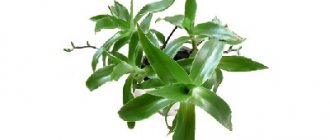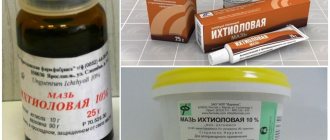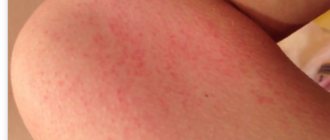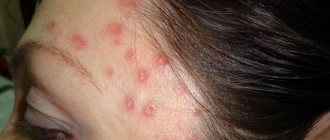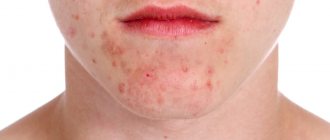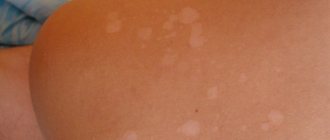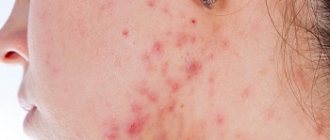Why do spots appear on the body?
According to medical indications, exhaustion of the nervous system aggravates not only the psycho-emotional state, but also the physical one. Various diseases can appear due to nervousness:
- Diabetes.
- Hypertension.
- Lupus.
- Vegetovascular dystonia.
- Gastritis, which later turns into a stomach ulcer.
- Allergic dermatoses.
All of the above ailments are a closed form of the disease, but the latter, unfortunately, cannot be hidden.
The appearance of spots on the body is one of the most unpleasant and discomforting diseases. After a lot of stress, the human body becomes exhausted. There are obvious changes in the general condition.
As a rule, the main indicator of nervousness is skin rashes on the body, appearing in the form of rashes, spots, blisters.
Areas where an allergic reaction due to nerves may occur:
- Face (cheeks, forehead, chin).
- Neck.
- Extremities (arms, legs).
- Body (stomach, chest).
Spots on the body can develop into other, more complex allergic diseases, possibly becoming chronic.
List of skin diseases:
- Small red spots that are itchy (urticaria).
- Scales, papules on inflamed skin (eczema).
- Dark red nodules affecting certain areas of the skin (lichen).
- Dry, overgrown plaques (psoriasis).
- White spots on dark skin (vitiligo).
There are many skin diseases due to nervous soil. The nature and form of the disease depends on the characteristics of the person.
Preventive measures
In the case of nervous urticaria, prevention and treatment go hand in hand. Although it is impossible to prevent stress-induced urticaria, through preventive measures it is possible to avoid further outbreaks and prevent the pathology from becoming chronic.
Pathology prevention measures include the following:
- Limit stress. This is the key condition. It is advisable to take care of this in advance. The simplest measure is not to resort to intense physical activity.
- Support from loved ones. Support from friends and family during times of stress can greatly calm your emotional state.
- Psychotherapy. A specialist will help you better understand your problems and teach you how to cope with stress in difficult situations.
- Phytotherapy. It is recommended to drink tea made from natural mint or other herbs with calming properties more often.
- Healthy lifestyle. This applies not only to nutrition and giving up bad habits. Moderate physical activity and maintaining a balanced rhythm are required.
- Rest. A vacation or a change of scenery will help.
- Massage. Relaxing massage sessions reduce nervous and bodily tension.
- Vitamin complexes. Taking vitamins will help improve the immune system and strengthen the body as a whole.
The main goal of prevention is to restore the patient’s emotional balance. From time to time it doesn’t hurt to consult a doctor, especially during periods of exacerbation. Also, for prevention purposes, you can use moisturizing and soothing creams or gels.
To achieve the desired effect, an integrated approach and regularity are required. Only in this case can we expect results.
Treatment of skin spots caused by nerves
Treatment can take different forms:
- At home (treatment with folk remedies).
- In general medical conditions (treatment with local drugs).
- In complex therapy, within hospitals, sanatoriums.
Diagnosis and treatment of spots on the body is as follows:
- An examination is carried out by a specialist, where the nature and extent of the disease is revealed.
- General tests are taken (blood from a vein, finger, urine).
- Skin samples and scrapings are taken.
- The level of immunoglobulin E is assessed.
- Afterwards, treatment is prescribed (use of external agents, oral medications, diet).
- A trip to a sanatorium by the sea is recommended (sea air has a beneficial effect on the condition of the skin and the whole body).
In order for the disease to go away, it is necessary to perform comprehensive, preventive care for the skin and the body as a whole. In the photo, spots on the body are caused by nerves, which will quickly help identify the disease. For successful therapy it is necessary:
- Eat properly.
- Goes to bed on time.
- Try not to get overtired.
- Be less irritated.
- Drink enough water.
- Avoid food and contact allergens.
- Move actively.
- Think positively.
- Strengthen the immune system through hardening; sunbathing, air bathing.
- Take care of your skin daily.
Allergic vegetative storm or panic attack
Nervous allergies (photos of physiological manifestations that may characterize the condition, below) do not make themselves felt all the time. That is why scientists introduced the concepts of “allergic vegetative storm” or “panic attack,” which better describes the patient’s condition. Such concepts mean an attack of anxiety, panic or excitement, which is accompanied by four or more physiological symptoms.
Could a rash be caused by nervousness?
Stress can affect more than just your emotional health. The reaction to overexertion causes a wide range of physical symptoms, such as rashes, dystrophic changes in the nails, and exacerbation of chronic diseases. Rashes can appear on any part of the body. After recovery, no traces remain - this confirms that the cause of dermatitis is nerves.
Scientists have proven that strong emotional experiences are associated with the appearance of acne or nettle fever. Areas of skin affected by dermatitis are red, inflamed, and swollen.
The spots can be the size of a pencil tip or the size of a five-ruble coin. People with allergies, neurodermatitis or sensitive, easily irritated skin should pay attention to intensive care.
Symptoms of a nervous rash
Skin rashes are a common physical symptom of stress. Everyday forms of stressful situations have little effect on the body. Nervous exhaustion leads to dermatitis and allergic reactions, manifested by the following symptoms:
- skin rashes (wet, dry, flaky);
- anxiety;
- itching;
- incessant burning;
- the appearance of blisters;
- shiver;
- decreased mood;
- sneezing;
- drowsiness.
Repetitive stress and facial skin are closely related. Eliminating the main symptoms will restore health to the skin.
Reasons for appearance
- Increased thermogenesis. When preparing a person for “fight and flight,” that is, in a state of anxiety, even if this anxiety is not clearly felt, the body’s heat production increases. This is fine. This releases histamine, which can cause rashes on the skin in the form of red spots. These spots may or may not be itchy.
- Sweating. Increased sweating is a classic symptom of anxiety. It can contribute to the formation of red spots on the skin in the same way as increased thermogenesis - leading to the release of histamine.
- Increased sensitivity. The skin often becomes more sensitive to various influences when a person is in a state of chronic anxiety. Such sensitivity can manifest itself as red spots on the skin and a rash. So sometimes people who had chickenpox in childhood, at times of stress, especially chronic stress, develop rashes on the skin characteristic of this disease.
- Unidentified reasons. Doctors often admit that they do not know why red spots appear on the skin during anxiety and worry, which do not itch and usually do not flake. The exact biological mechanism for the appearance of this symptom in many cases remains unclear. Often only one thing is clear – these are “nerves”.
It is known that some people are more prone to redness of the skin under stress, others less so. Often such differences are associated with anatomical features: for some, the capillaries are located very close to the surface of the skin, for others - a little deeper.
Types of nerve rash
Spots and rashes due to nervous stress are localized on one part of the body and move to another, covering a large area. The rash comes in different forms. Stress can prevent existing skin problems (psoriasis, eczema) from healing properly. The affected areas itch and cause discomfort.
A nervous allergy is considered acute if it resolves after 9 weeks. When symptoms cannot be completely and permanently cured, the condition is considered chronic.
Nerve allergies
Research has shown that stress increases allergic reactions. Addressing anxious behavior will reduce sensitivity to allergies.
The following symptoms indicate a nervous allergy:
- chills;
- fever;
- oppression;
- spots and pimples appear on the skin;
- irritation of any area of the body, causing the desire to itch.
To prevent environmental and psychological factors from putting too much strain on the skin, it is necessary to maintain its moisture and elasticity.
Hives
Hives are considered a common type of rash characterized by the formation of raised, red, itchy patches on the skin. The cause and severity of the condition varies; only specialists will be able to find the cause of the spots.
Nervous system symptoms
If the manifestations listed above can also occur with true allergies, then the nervous form of the disease is also characterized by exceptional symptoms. Nervous allergies are distinguished by certain mental manifestations, among which are:
- increased irritability;
- frequent mood changes;
- depression;
- confusion of thoughts;
- weakness, loss of strength, drowsiness;
- decreased performance and concentration;
- recurrent headaches;
- decreased visual acuity, “fogging,” although no physiological problems are diagnosed.
Treatment of nervous rashes
Most allergic reactions to stress go away on their own, i.e. without treatment. Skin areas can be treated well at home. A common treatment is an over-the-counter (OTC) drug. Antihistamines relieve symptoms such as itching, quickly block receptors, and are available at reasonable prices.
Over-the-counter medicines:
- Diphenhydramine;
- Diazolin;
- Tavegil;
- Cetirizine (Zyrtec);
- Fexofenadine (Allegra);
- Loratadine;
- Claritin;
- Xizal;
- Suprastin;
- Oral anti-itch medications.
At home, a cool compress applied to the affected areas will help stop the development of an allergic reaction. Skin after stress requires additional care and attention.
To treat severe conditions, you can take sedative, metabolic drugs with proven effectiveness:
- antihistamines;
- valerian tincture;
- Phytosed;
- Novo-Passit;
- corticosteroids (Prednisone);
- antibiotics (Dapson-Fatol);
- injection type (Omalizumab).
If you experience swelling of the face, difficulty breathing or shortness of breath, you should consult a doctor immediately. These are life-threatening complications that require an injection of epinephrine for treatment.
Dear readers! We strongly recommend that you consult a doctor before taking medications or self-medicating. There are contraindications.
Nervous (neurodermatitis) dermatitis
In the crazy pace of modern life there is absolutely no time to relax. Due to constant stress and the inability to get proper rest, health problems inevitably arise. One of the common consequences of stress is nervous dermatitis. The high-risk group includes people who suffered from atopic eczema in childhood, as well as those prone to allergic reactions and those suffering from psoriasis. This disease occurs predominantly among women, as they are more emotional than men and are more likely to worry about minor troubles in life.
Why does nervous dermatitis occur, symptoms and treatment methods?
To make a diagnosis, you need to know the main signs of neurodermatitis. Let's look at the causes, symptoms and treatment methods for nervous dermatitis.
Characteristics
This disease is almost no different from other similar skin diseases. The following symptoms of nervous dermatitis are distinguished:
- intense itching that appears after stress;
- skin manifestations in the form of large red spots;
- the presence of small rashes and even blisters;
- the appearance of microscopic cracks in the affected area.
Signs of dermatitis can affect the quality of sleep; nerves often cause a significant increase in blood pressure in patients. When a person calms down, the symptoms noticeably weaken, but as soon as stress arises, the disease reappears.
Neurodermatitis occurs mainly on the face, knees and elbows. There are the following forms and clinical manifestations of the disease:
- hypertrophic – the appearance of rashes in the groin area;
- follicular – the appearance of a rash on the hairy areas of the body;
- linear - the formation of spots that look like straight lines on the arms and legs;
- organic – inflammation in local areas;
- formation of scales on the face.
Each form of the disease has its own characteristic features, based on which the characteristics of therapy for a particular patient are determined.
Nerve spots development stages and symptoms
The spots differ in shape and stage of development of the disease. But in general, the following stages of development can be distinguished:
- the appearance of stains;
- increase in size and number of spots;
- itching, tingling and irritation.
Due to irritation, a person scratches the spots, which leads to inflammation and open wounds. Without proper care and treatment, wounds can become infected. Scratching also leaves scars.
Nervous urticaria
Red dots appear, similar to nettle burns. Gradually they merge together and begin to itch.
Nervous scabies
Develops quickly. First, itching occurs in one place, which quickly spreads throughout the body. Rashes appear on the buttocks, abdomen, and thighs. They look like red blisters and don't look like typical scabies. At the same time, the person feels weak and tired, the temperature rises, and trembling occurs. The itching intensifies in the evening and after taking a warm bath.
Nervous psoriasis
An autoimmune disease that worsens under stress. First, plaques form on the body, and then a thin film. She sometimes bleeds.
Nervous allergies
Nervous allergies occur exclusively against the background of emotional upheaval. But in terms of physical manifestations, it is no different from a chemical allergy: itching, redness, rashes, cough, runny nose, chills. From the psychological point of view, the following are observed: irritability, emotional swings, confusion, weakness, decreased cognitive abilities, cephalalgia, blurred vision.
Nervous eczema
Red pimples appear, similar to allergies. First, redness of the skin occurs, then a bubble of liquid forms at this place. A little later, it bursts, a wound is formed, which is covered with a yellow crust.
Features of rashes in children
In children and adolescents, the rash is accompanied by severe itching. It interferes with sleep and makes the child irritable and aggressive.
The main causes of the disease
Do not underestimate the pathologies that arise from nervousness. The disease is characterized by the appearance of rashes similar to allergies. It must be remembered that such dermatitis does not arise from nerves alone - everything is much more complicated.
Let's consider the main causes of neurogenic dermatitis:
- weakened immunity after illness;
- metabolic disease;
- poisoning;
- chronic inflammatory process;
- long-term depression;
- vegetative-vascular dystonia;
- excessive mental and physical stress;
- vitamin deficiency;
- bad habits;
- acute and chronic diseases of the gastrointestinal tract.
ATTENTION! In some cases, nervous dermatitis develops as a manifestation of an allergy to medications that stimulate or, conversely, inhibit the functioning of the central nervous system.
Physical manifestations of allergies
Nervous allergies manifest themselves with the same general symptoms as any other type of individual reaction to foods or other irritants. Thus, patients primarily complain about dermatological manifestations, which include:
- rashes that are accompanied by itching (the symptom most often appears on the face, hands and scalp);
- a rash that may appear in the mouth; this condition is often confused with incipient stomatitis;
- urticaria - red blisters appear, slightly rising above the surface of the skin;
- runny nose, which appears even in warm weather and is characterized by mucous discharge, lacrimation;
- dry cough - a symptom that accompanies allergies and persists even after taking antitussive medications;
- a feeling of lack of air, in some cases posing a serious threat to life and health;
- excessive sweating, rapid heartbeat and shortness of breath even with minor physical activity;
- trembling in the body, chills or fever, nausea are signs of pseudo-allergy, which do not appear as often as other symptoms;
- paleness of the skin, especially on the limbs and face;
- unpleasant sensations, discomfort in the chest, solar plexus;
- Digestive problems - a symptom that occurs somewhat less frequently than typical skin manifestations of allergies.
The set of signs characterizing this type of reaction may vary depending on the individual characteristics and degree of sensitivity of the body. A particular danger arises when swelling of the respiratory organs develops, because in this case suffocation is possible. Sometimes a nervous allergy (the symptoms are more serious) is accompanied by fainting.
